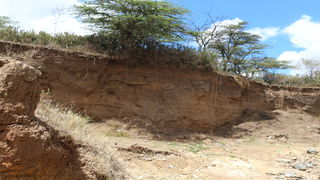
The erosion in the village has been getting progressively worse over the last several years with locals fearing the weather event changes could cause landslides.
| Geoffrey Ondieki | Nation Media GroupSamburu
Premium
Soil erosion threatens to wipe out entire village in Samburu
When Elias Lesiimam moved to Loresho village in Maralal, Samburu County, he looked forward to living in the area due to its proximity to the town centre.
Ten years later, though, he and other villagers risk being rendered homeless following massive erosion that has left the village literally on the edge.
The ground around the village has over the past five years, been gradually washed away by rain waters that have created large swells and high waves, digging over 25 meters deep.
The erosion of the area has been worsening by the day.
Locals who spoke to the Nation said they were concerned that local and national governments had done nothing to avert the looming disaster, despite them having genuine land ownership documents.
“We are frightened and vulnerable because the situation here is getting worse as it is also risking the lives of school-going children," Mr Lesiimam lamented.
The waters have created gullies up to 25 metres deep and residents are worried that the ongoing rains will sweep away houses in the area since huge swells wreaked havoc between April and September last year.
Part of the deep gulley at Loresho village in Maralal, Samburu County.
A resident, Joseph Lekempe, said that three of his cows had died after falling into the gully while grazing. Since then, he said, he has resorted to grazing his animals away from the village to avert more deaths.
"I lost my cattle here previously and the gullies are a risk to humans too. We need a long-term intervention," he told nation.africa.
Poor soil structure
National Environment Management Authority (Nema) county director Patrick Lekenit attributed the erosion to natural causes and human activities in Kirisia forest. Mr Lekenit says poor soil structure remains the biggest challenge in most places in Maralal.
Mr Lekenit admitted that there had been significant erosion and sand loss.
He further explained that due to increased deforestation in the upper sections of Kirisia forest, the velocity of water increases as it approaches the lower parts of Maralal thus creating gullies.
He said that is one of the reasons why stakeholders resolved to get locals out of the forest to allow restoration programmes.
Part of the huge gulley at Loresho village in Maralal, Samburu County.
"Human activities such as deforestation have for a long time contributed to the rapid expansion of the gulley in the Loresho area. Evicting pastoralists out of the forest was our long-term solution to prevent further degradation," Mr Lekenit said.
The official noted that the ever-expanding gulley is posing risks to the villagers in the region. However, he revealed that Nema, together with Maralal town municipality, are crafting short-term measures to avert possible disasters.
He confirmed that they are set to commence physical work to protect lives in the area.
"There is a great danger in the Loresho village because we have received cases where animals have died as they fall in the deep gulley. We have organised physical work to avert more incidents in the area," he added.





